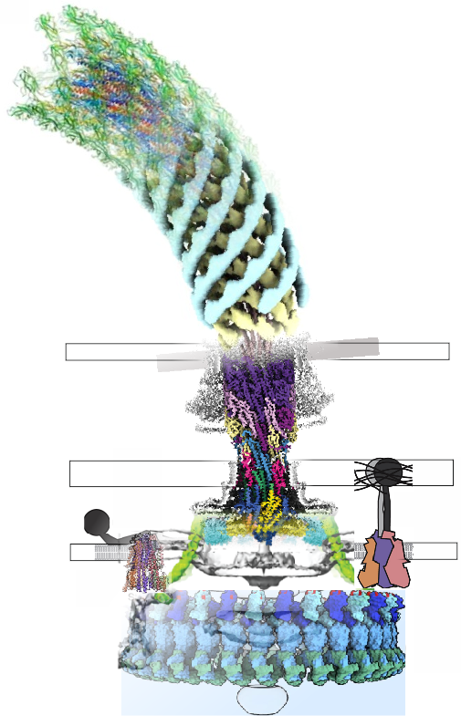T he bacterial flagellar motor is a rotary molecular engine powered by the flow of ions across the inner, or cytoplasmic, membrane of a bacterial cell envelope. Each motor drives a protruding helical filament, and the rotating filaments provide the propulsive force for cells to swim. The flagellar motor is perhaps the best studied of all large molecular machines. The image on this page is a composite of structures, obtained mostly by cryo electron microscopy, mostly published in 2020 and 2021.
he bacterial flagellar motor is a rotary molecular engine powered by the flow of ions across the inner, or cytoplasmic, membrane of a bacterial cell envelope. Each motor drives a protruding helical filament, and the rotating filaments provide the propulsive force for cells to swim. The flagellar motor is perhaps the best studied of all large molecular machines. The image on this page is a composite of structures, obtained mostly by cryo electron microscopy, mostly published in 2020 and 2021.
These structures - along with the latest advances in our lab in optical measurement of live, working, single motors - will help us to understand in detail how the flagellar motor works.
Filaments rotate at 100s of revs per second in swimming cells. The rotor is the heart of the motor: a set of rings in the cytoplasmic membrane, about 45 nm in diameter, and containing a total of a few hundred molecules of several different proteins. This is surrounded by a ring of independent torque generators which are anchored to the cell wall and consist of the proteins MotA and MotB. There is room for at least 11 torque generators in E. coli, maybe as many as 16 in other species.
Mechanism
Structures obtained in 2020 of the torque-generators show a MotA5MotB2 complex spanning the cytoplasmic membrane, suggesting models in which the A5 pentamer rotates around the B2 dimer, coupled to proton flow. These “little wheels” would then push like miniature cogs on the perimeter of the “big wheel”, turning the whole rotor and attached filament. We aim to find out whether this model is correct, and if so to fill in the details, via measurements on single, working motors.
Structural dynamics
We discovered in 2006 that many of the protein components of the flagellar motor exchange with spare parts in the rest of the cell, on a timescale of minutes, even while the motor is working. This is now understood to be a general property of most if not all large molecular machines. We are working out the extent of this protein exchange in the flagellar motor, and some of the functions that it performs.
Assembly
Building a flagellar motor is a complicated process. We have discovered a new mechanism, “domain-swap polymerization”, that stabilizes parts of the motor while preventing them forming unwanted stable complexes elsewhere in the cell. We are using DNA nanostructures to try and take control of the assembly process, by acting as artificial templates for the formation of the flagellar rotor. As well as understanding how this particular machine is built, this will help us to understand the assembly principles of large molecular machines in general.
